A mystery album has fallen into my possession. The photos suggest it belonged to a wealthy, well-travelled but thus far unidentified family. No doubt Puffins will help me to solve the puzzle but first, two near century-old Velox prints from the Stockton and Darlington Railway centenary beg the telling of an interesting story.

LNER No.2563 started life as an A1 4-6-2 Pacific. Designed by Sir Nigel Gresley and built in Doncaster in 1924, No.2563 was named ‘William Whitelaw’ after the chairman of the newly grouped London and North Eastern Railway. Rebuilt as an A3 in November 1942, in British Rail ownership it was renumbered as 60064 and withdrawn from service in September 1962.
None of the A1/A3s has survived into preservation other than celebrity 4472 Flying Scotsman (later renumbered 60103). 4472 has been restored and was in steam as recently as the 22nd August 2021 when it traversed the Settle to Carlisle railway hauling The Waverley from York to the Border City.
So much for the A1/A3s and 2563 but what of William Whitelaw the man? Another interesting story, best started with a disambiguation. The William Whitelaw in question was the grandfather of Viscount Whitelaw, Mrs Thatcher’s one time Home Secretary and Deputy Prime Minister who was affectionately known as ‘Willie’.
A long line of landed Whitelaws of Gartshore in Dumbartonshire served in Parliament and worked in industry. How so? Their ancestor, Alexander Whitelaw was born in 1823, two years before the maiden run of George Stephenson’s Locomotion No.1 on the Stockton and Darlington Railway. In 1859 he married into trade, his wife being Barbara Forbes Lockhart of the William Bairds and Company coal and iron dynasty.
Alexander Whitelaw was Conservative Member of Parliament for Glasgow between 1874 and his death in 1879. His second son, Graeme (1863-1928), was Conservative MP for North West Lanarkshire.
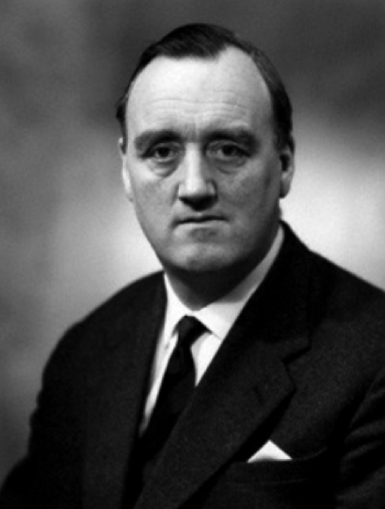
William Whitelaw in 1963,
Bassano Ltd – Fair use, illustrative, low resolution, deceased,
William (1868-1946), his third son, was briefly Tory MP for Perth after completing his education at Harrow and Trinity College, Cambridge. Away from politics, he was a director and then Chairman of the Highland Railway, Chairman of the North British Railway and, when the NBR, HR and others were grouped together in 1923, the chairman of the newly created parent company, the London and North Eastern Railway. He was also the paternal grandparent of Willie, his son being William Alexander Whitelaw, Willie’s father.
Regular readers might recall being bored senseless by (en route to an iron ore mine in Arctic Sweden) the tale of half of my family fortune being wasted on an investment in the Rothbury Railway, one of the Duke of Northumberland and my ancestor’s more over-optimistic get rich quick schemes.
Sad to say, the other half of our country estate was reduced to clinker by the North British Railway. The silver lining, attached to black smoke billowing from a rickety engine, being correspondence with NBR and subsequent LNER chairman William Whitelaw that sits in an attic deed box beneath my appropriately underused and underfunded model railway.

Even before the First World War had ended, storm clouds were gathering over Britain’s myriad of war-ravaged railway companies. As early as 1918 an ancestor had taken the precaution of joining the Scottish Railway Stockholders Protection Association, chasing after bad money with good by parting with five shillings.
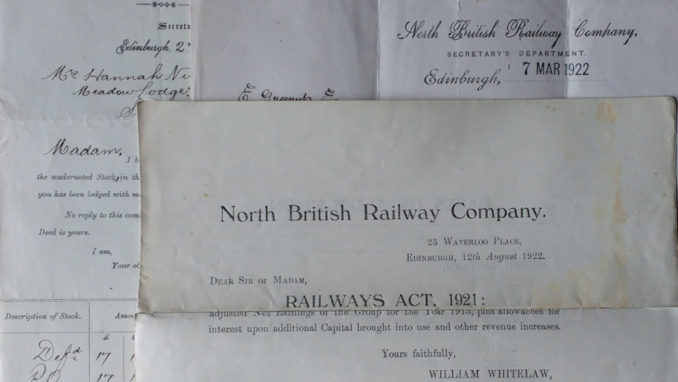
To little avail. The North British stock was replaced with a stake in the LNER which, at the nationalisation of the railways in 1948 after some more war ravaging, was swapped for British Transport 3 Percent Guaranteed Stock. Based on the Government’s 1946 valuation of the companies, at that point our family stake in Britain’s Railways was worth an unimpressive £1 2/6. This investment generated two dividend payments a year of four old pence on which you then had to pay income tax.
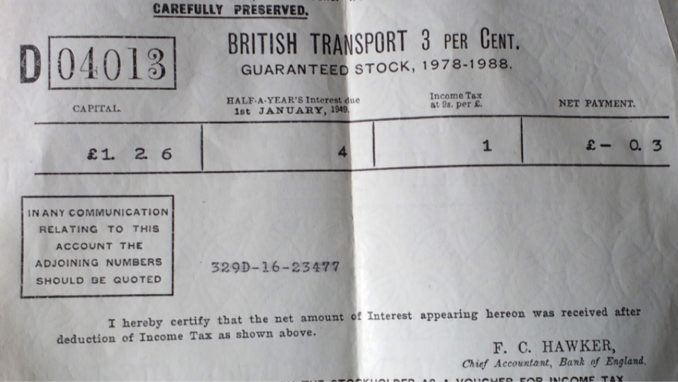
As yet further proof that not much changes and gullibility is genetic, your humble author put his pennies into Railtrack when it was privatised in 1994. In the absence of a world war, seven years later the Government invented a new type of torture called ‘Railway Administration Under the Railways Act 1993’ which put yet further distance between myself, a hereditary seat in Parliament and a society introduction benefiting from her own pig-iron works.
The Whitelaws of this world certainly, especially in the early decades of the 20th century, had it better than the rest of us.
Or did they?
Willie Whitelaw’s parents, William Alexander and Helen Winifred Cumine Russel married in St George’s Hanover Square, London on April 14th 1914. All present in the John James designed 1724 Mayfair parish church will have realised war was approaching as the Balkans chuffed towards the precipice.
The bride, known as Winifred, was one of the Russels of Aden. Her father was the late Major General Francis Shirley Russell of Aden, military attache to Berlin between 1899 and 1901 and Member of Parliament for Cheltenham between 1895 and 1900.
Within months the world was at war, with William Alexander joining the Argyle and Sutherland Highlanders. By October 1915, he was a second lieutenant. In 1918 he became both a lieutenant and a father. His son, William Ian Stephen ‘Willie’ Whitelaw, was born on 28th June of that year.
Gassed during the war, William Alexander succumbed to his wounds and died of pneumonia on 14th February 1919 when his son was only 8 months old.
William Alexander’s younger brother, Robert Hillary Lockhart Whitelaw was sent to the Western Front on November 8th 1916 after gaining a commission in the Royal Horse Guards. Robert was wounded near Arras on 7th May 1917 and died of wounds in No.8 General Hospital, Rouen on the 28th May. He is buried in St.Sever Cemetery, Rouen. and remembered on the war memorial in Liberton Cemetery, Edinburgh.
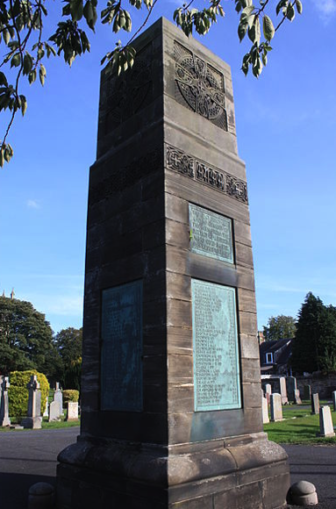
Liberton War Memorial, South Edinburgh,
Stephen C Dickson – Licence CC BY-SA 4.0
The youngest of the three Whitelaw brothers, Geoffrey Lacey Whitelaw is also remembered in Edinburgh, on Loretto school’s war memorial screen. His citation reads,
To the glory of God and happy memory of Geoffrey Lacy Whitelaw 2nd Lieutenant 1st Life Guards Reserve. Served in France May to October 1917. Three times wounded. Died at Edinburgh 14th April 1918 of illness contracted on active service. Loretto 1912-1916. Cricket XI 1913, 14, 15. Football XV 1915-1916. Rejoice in the Lord always and again I say rejoice. A tribute from the school.
Loretto’s roll of honour adds 2/Lt Whitelaw went to France in May 1917, was wounded on July 15th and wounded again on August 22nd. He was hurt in the leg on October 12th but remained in action for a further 12 hours. The following year, now aged 19,
After convalescence Leit. Whitelaw was passed “fit” in March 1918, but just after this he had an attack of enteritis and appendicitis. He was operated on, but after a plucky fight died on April 14, 1918.
Willie’s mother’s side of the family fared little better. Her brother, Drostan Arthur Cumine Russell of Aden was an officer in the Rhodesian Rifles. Aged 23, he died of blackwater fever on the 25th July 1915 whilst on active service at Mutotini’s Village, near Ndola in Northern Rhodesia. Puffin’s who sat beside a Northern Rhodesian copper belt ex-pat at school have permission to skip the next paragraph.
Ndola is the commercial and industrial centre of modern-day Zambia’s (formerly known as Northern Rhodesia) copper belt. It is the capital of the copper mining region and the capital of Copperbelt Province. It lies six miles from the border with The Congo (DR Congo) and 690 miles from Bulawayo in Southern Rhodesia (Zimbabwe). In 1907 Rhodesian Railways reached Ndola from Bulawayo and continued laying track until connecting with the Benguela Railway which led to the Atlantic coast at Lobito. Along this route, copper could be exported via The Congo and Portuguese West Africa (Angola).
Although during the First World War Rhodesian Railways were served by conventional but narrow gauged 4-8-0 locomotives, by the middle of the next decade (co-incidental with the centenary of the Stockton and Darlington Railway), RR was talking delivery of Beyer Peacock 2-6-2+2-6-2 Garrets. These engines were ideal for the long runs, poor fuel, tight curves and basic track in the copper belt and other far-flung parts of the Empire.
Although over 1000 Garretts were built by Beyer Peacock, few were used in Britain, one of those that were being our final 1925 cavalcade engine, an LNER U1.
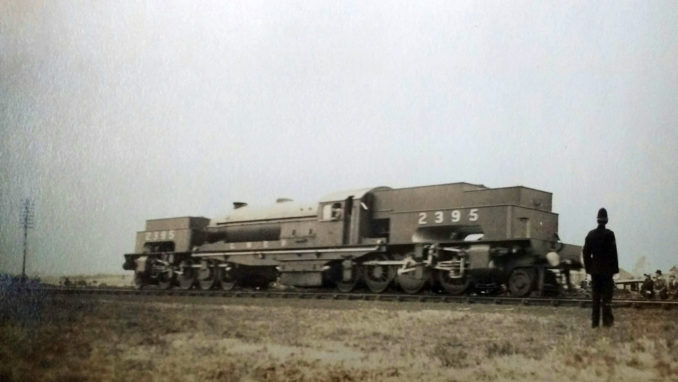
No.2395 was a solitary Class U1 designed to bank coal trains along Worsborough Bank on the Woodhead route between Sheffield and Manchester. ‘Banking’ is a process whereby an extra engine is attached to the back of a train to help propel it up a steep gradient. The locomotive is pictured above brand new, having just been delivered from the Bayer Peacock works at Gorton, Manchester. Although the company are long gone, parts of their giant locomotive works at Gorton Lane are still standing.
***
There is a God in heaven. A divine symmetry gives proof to His mighty works. Plus, He is keen on railways. Half a century after the mystery album photographs were taken, our final snap relates to the 150th anniversary of the Stockton and Darlington Railway held at Shildon on August 25th 1975. George Stephenson, the designer of Locomotive No.1 the first S&DR engine, was honoured by having Stanier black five 44767 named after him. Appropriately the Rt Hon Willie Whitelaw, then MP for Penrith and the Border and Deputy Leader of the Conservative Party, unveiled the plaque. Despite my continuing lowly social status, your humble author was on hand to take the photo with Mr Whitelaw, ever the gentleman, kind enough to get out of the way when politely asked.
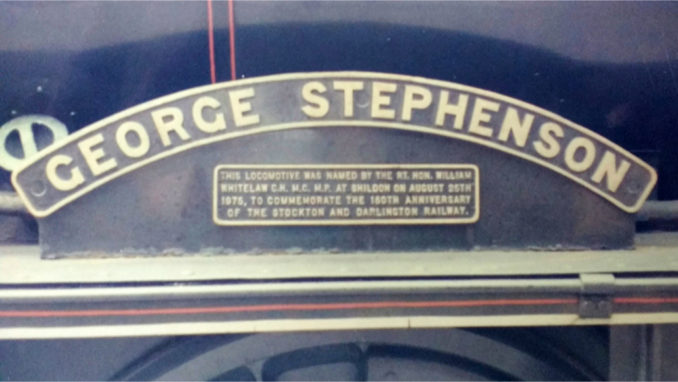
With gratitude to
The Commonwealth War Graves Commission
Loretto School
The Peerage.com
The Western Front Association
Wiki
© Photographs, unless otherwise stated, and text 2021 Always Worth Saying
The Goodnight Vienna Audio file
Audio Player



